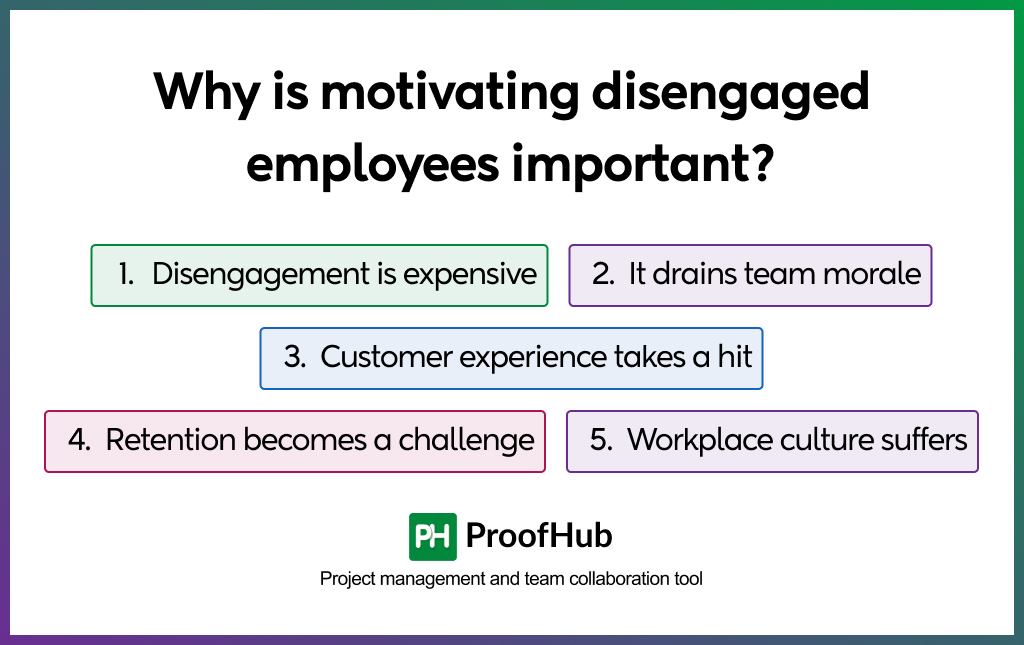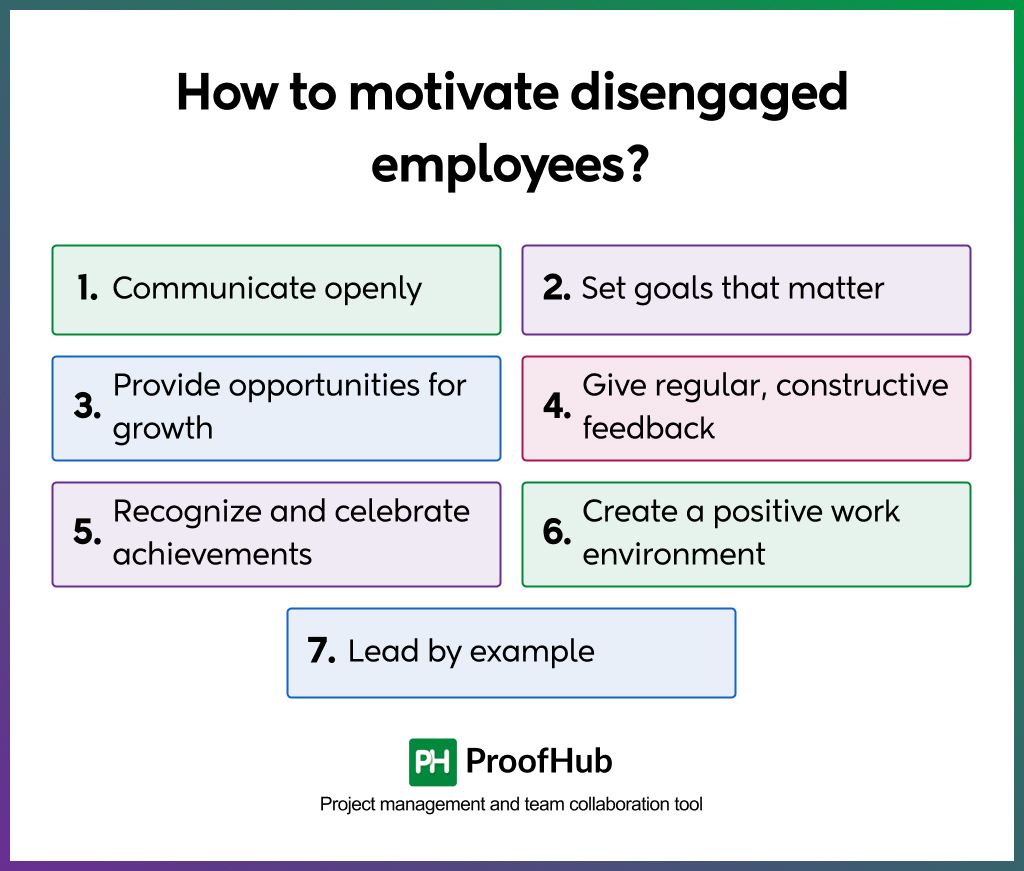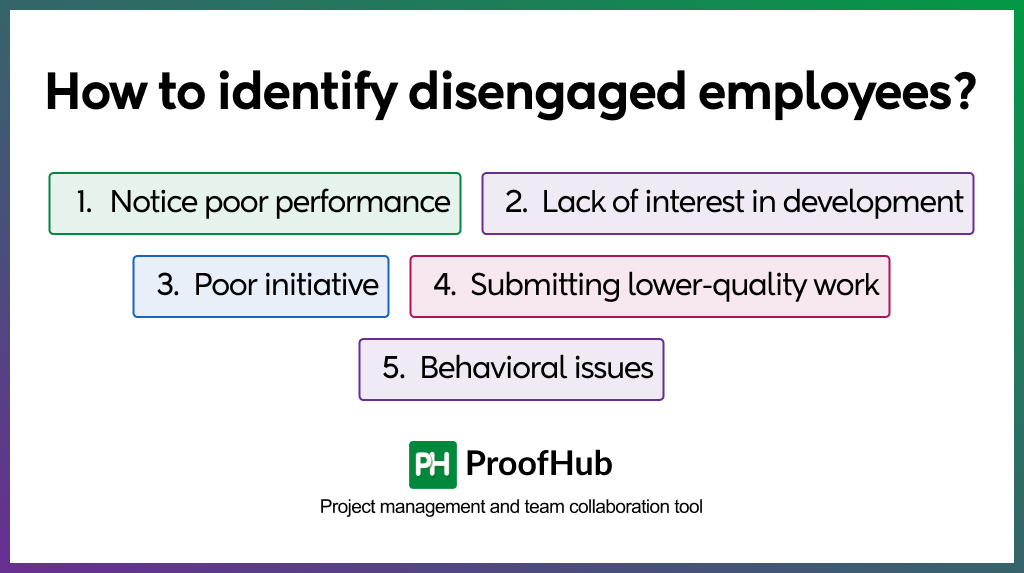Employee disengagement is a silent killer of workplace productivity and morale.
Ever walked into a team meeting where half the room looks bored, barely saying a word, and just seems to be counting the minutes until it’s finally over? How frustrating this can be, right? These are the signs of disengaged employees. Disengaged team members not only slow things down but also affect team energy, hurt morale, and affect the whole business.
But most people don’t start off disengaged. Somewhere, something happened that made them lose their interest. Either they were left unappreciated by their manager or stopped getting bothered to a certain point.
As a manager, you, too, have two options: either you ignore it and let the problem get worse or step in and turn things around. The good news? You don’t need big budgets or flashy perks to fix it. A few simple leadership moves—things that make people feel heard, valued, and challenged—can make all the difference.
By spending more than 25 years, I can assure you that, with the correct tactics, you can reignite employee motivation, restore trust, and establish an environment where workers feel appreciated and inspired.
Here, I will share my firsthand experience of the key reasons behind employee disengagement and the proven strategies to turn things around.
Who is a disengaged employee?
A disengaged employee is someone who has lost enthusiasm for their work and no longer finds joy in their role. They may complete tasks, but without passion, curiosity, or connection to the outcome.
Moreover, disengaged employees often show up physically but not mentally. You will see it in the little things: quiet during meetings, slow response times, lack of feedback-seeking, or avoiding collaboration.
Recognizing disengagement is step one. Re-engaging them? That’s where strong leadership steps in.
Why is motivating disengaged employees important?
Motivating disengaged employees is crucial for maintaining a healthy, productive, and collaborative work environment. If left unchecked, disengagement can drain the morale of other team members.

Here’s why re-engaging disengaged employees is necessary for you:
1. Disengagement is expensive- really expensive
Think about it: Every missed deadline, mistake, and wasted hour adds up. A disengaged team isn’t just slow—it’s a financial drain.
Disengaged employees are 18% less productive, meaning they take more time to complete tasks or often make mistakes, which cost the company thousands of dollars. Gallup estimates that disengaged employees in the U.S. account for approximately $1.9 trillion in lost productivity nationally.
Learn how to avoid making mistakes at work
2. It drains team morale
Disengagement is not limited to the particular person; it can affect others as well. When a team member isn’t contributing their best effort, it can frustrate high performers and create a domino effect. At that time even the best employees may start questioning why they should keep pushing when others aren’t pulling their weight.
3. Customer experience takes a hit
Disengaged employees struggle to deliver quality service. They may seem indifferent, impatient, or unwilling to go the extra mile for customers. This can result in negative interactions, damage to the company’s reputation, and lost business. After all, customers can sense that they are dealing with someone who doesn’t care.
4. Retention becomes a challenge
A disengaged employee is at risk of seeking fulfillment elsewhere. Retention becomes a struggle when employees feel disconnected from their work or undervalued.
5. Workplace culture suffers
Disengaged employees struggle to collaborate effectively, making it challenging to maintain a positive and productive workplace culture. They are less likely to engage in team-building activities, contribute fresh ideas, or go the extra mile to overcome challenges.
Discover team-building activities to develop positivity at the workplace
What are the causes of disengagement at work?
There are several reasons for disengagement at work, like poor management, unclear expectations, problems with the feedback session, and more. Now, let’s explore some of these causes.
1. Poor management
One of the most common causes of employee disengagement is ineffective management. When, as a leader, you fail to provide clear direction and support, employees often feel disconnected from their work. They will wonder if their efforts are valued or if their contributions make a difference. In fact, many employees have shared their experiences on why disengagement happens in the workplace, highlighting how poor leadership can lead to frustration and lack of motivation.
2. Unclear expectations
Clear expectations are essential for employees to understand their roles and responsibilities. When employees are unsure about what is expected of them, confusion and frustration set in, and they become demotivated and disengaged.
3. Lack of feedback
When employees don’t receive regular feedback on their work, they feel undervalued and uncertain about their performance. They may struggle to understand whether they are meeting expectations or how they can improve. This lack of feedback can lead to frustration and a decline in engagement.
Also read: How to give effective project feedback
4. Organization centric approach
When an organization is positioned at the center of every decision, prioritizing its goals over employee well-being can lead to disengagement. Employees may feel like mere cogs in the machine, with little regard for their growth or work-life balance. This approach often results in a lack of motivation and, ultimately, increased turnover.
5. Unsatisfactory pay and benefits
Inadequate pay and benefits can cause employee disengagement. Workers won’t feel invested in their tasks if they aren’t paid for their time and effort. They are also less likely to be engaged in the workplace when they are preoccupied with issues like rent, groceries, and child care.
6. Lack of rewards and recognition
If your employees put all their efforts into their work and rarely receive any reward for their achievement, they will eventually burn out and become disengaged. A lack of recognition not only affects individual morale but also impacts overall team performance.
Find out 14 employee recognition software used widely across the globe
How to motivate disengaged employees? (7 actionable tips)
Re-engaging disengaged employees requires more than just a simple fix—it demands intentional actions and a focused leadership approach. Here are seven actionable strategies you can implement today to motivate your disengaged team members.

Let’s find out 7 ways to motivate an employee who is disengaged.
1. Communicate openly
One of the most powerful ways for a leader to re-engage employees is through clear and open communication. Employees often disengage when they feel unheard, disconnected, or uncertain about their roles and expectations. Regular conversations help bridge this gap by making them feel valued and understood.
Start by actively listening to their concerns and asking open-ended questions to understand their perspective. Be transparent about company goals, changes, and expectations so they don’t feel left in the dark. A simple one-on-one conversation can go a long way in making an employee feel seen, heard, and motivated to contribute again.
Also read: 11 Top employee communication software to improve productivity
2. Set goals that matter
As a leader, setting clear and achievable goals can help disengaged employees regain their sense of purpose and direction. Without well-defined objectives, employees may feel lost, unmotivated, or even become a distraction to others. Collaborative goal-setting ensures that employees understand their role in the bigger picture and feel more connected to the team’s success.
Using project management tools like ProofHub can make this process more structured and effective. With ProofHub, you can break down larger objectives into smaller, manageable tasks, assign responsibilities, and track progress in real-time.
3. Provide opportunities for growth
Employee engagement often declines when individuals feel low improvement and have no clear path for development. Employees want to enhance their skills, take on new challenges, and advance their careers.
Investing in training programs, mentorship, coaching, and skill-building workshops empowers employees to expand their capabilities and stay engaged in their work.
Many leading companies understand the importance of continuous learning and professional development:
- Google: Google allows employees to spend 20% of their time on passion projects, leading to innovations like Gmail and Google News.
- Amazon: Amazon invests heavily in employee upskilling through programs like Career Choice, which pre-pays tuition for employees to learn in-demand skills, even if they pursue careers outside the company.
4. Give regular, constructive feedback
Establish regular feedback mechanisms, both formal and informal. Scheduled performance reviews and constructive feedback sessions. It helps disengaged employees stay on track, feel valued, and understand how to improve their performance.
Additionally, creating a two-way feedback system – where employees can also share their thoughts about leadership, workplace culture, and process ensures that engagement efforts are meaningful and impactful.
5. Recognize and celebrate achievements
Disengagement often occurs when employees don’t feel appreciated for their work. Praising and recognition programs are a great way to show employees that their work matters to the organization. It’s a sign of a highly collaborative organization. These are most effective when they’re transparent, consistent, and tied to specific achievements. Employees should understand what behaviors and contributions are being recognized.
You can acknowledge employees’ contributions through verbal praise, awards, or incentives—not just privately but publicly, through the organization’s intranet or newsletter.
Discover 25 employee recognition ideas to appreciate your team’s hard work
6. Create a positive work environment
Employees feel more motivated to work if they observe that their managers or leaders create a positive work environment. A positive workplace environment encourages disengaged employees to reconnect with their work and contribute meaningfully to the team.
To foster a positive work environment, focus on building a culture of trust, transparency, and appreciation. Small gestures, such as celebrating milestones, offering flexible work arrangements, and promoting teamwork, can also create a workplace where employees feel inspired and committed.
You can also conduct a poll, asking your teammates to share what kind of improvement they want in the workplace.
7. Lead by example
“A leader is one who knows the way, goes the way, and shows the way.” – John C. Maxwell
As a leader, your actions set the tone for the entire organization. Employees look to you for guidance, and how you engage with your work directly influences their motivation and commitment. Demonstrating enthusiasm, accountability, and a strong work ethic shows employees what is expected and inspires them to follow suit.
When leaders actively participate in team efforts, acknowledge contributions, and commit to personal and professional growth, it reinforces the importance of engagement across all levels.
How to identify disengaged employees?
Spotting disengaged employees early allows you to take proactive steps before the issue escalates. Here are some clear indicators to help you recognize disengagement in your team members.

Here are some of the signs of disengaged employees so you can identify them.
1. Notice poor performance
Performance is usually the first to decline when employees are disengaged. Employees may begin missing deadlines or offer excuses rather than admitting their slow work. They might still perform their daily tasks, but they are not actively engaged in it.
Explore our comprehensive list of 8 tips to stop missing deadlines at work!
2. Lack of interest in development
Watch for employees who stop participating in team meetings, rarely contribute new ideas, and are withdrawn during one-on-one discussions.
Disengaged workers just complete their tasks as assigned and lose the will to aim higher.
3. Poor initiative
Disengaged employees often do only what is required and nothing more. They may avoid taking responsibility, stop sharing ideas, and avoid problem-solving. This usually happens because they lose interest, feel unmotivated, or believe their efforts don’t matter.
4. Submitting lower-quality work
One of the clearest signs of employee disengagement is a noticeable decline in work quality. When an employee who once delivered high-standard results starts producing subpar work, it may indicate a lack of engagement in their role.
5. Behavioral issues
Occasionally, moving around the office or chatting briefly with colleagues is normal. However, the problem arises when this becomes excessive. For instance, if an employee spends most of his time engaging in non work-related conversations or consistently distracts others, it can negatively impact productivity.
Learn more about how to manage disorganized people at work to help them regain control over their tasks and responsibilities.
How can disengaged employees affect team performance?
Disengagement doesn’t just affect the individual employee—it can have far-reaching consequences on overall team performance. Here’s how disengagement can negatively impact your team and business.
Here are some of the ways disengaged employees affect team performance.
1. They drain the energy of engaged employees
Disengaged employees can bring down the morale of even the motivated team members. Their lack of enthusiasm, low productivity, and negative attitude can frustrate team members who are putting in their best efforts. Over time, this toxic work environment spreads to such an extent that it makes the engaged employees feel drained and demotivated.
2. More conflicts, less cooperation
Employees may become impatient, less cooperative, and more prone to frustration when disengaged. This can result in miscommunication, resistance to collaboration, and even workplace tension. Instead of working together, teams waste time on misunderstandings and conflict resolution.
3. Costly mistakes and oversights
Missing details is a common habit of disengaged employees, which makes them more prone to mistakes. All this results in costly errors and poor and even reputational damage for the company.
4. Weak team collaboration and innovation
Disengaged employees are less likely to give ideas, cooperate successfully, or participate in brainstorming sessions. This constantly limits the creativity and innovation of the team, which diminishes the capacity to answer issues and propel business accomplishment. You can use collaborative tools to encourage participation, streamline idea-sharing, and foster a more interactive team dynamic.
5. Productivity takes a hit
Disengaged employees often put in less than the required effort, decreasing productivity. As a result, the burden often falls on engaged employees, increasing their workload and frustration.
The bottom line for leaders and managers
Employee disengagement doesn’t happen overnight; it’s a continuous process. If you don’t recognize the warning signs early, you risk losing valuable talent before you even realize there is a problem. So, ask yourself these questions: “Do I know what’s causing disengagement in my team?” “Have I created an environment where employees feel heard, valued, and motivated?” and “Am I addressing the root cause or just reacting to the signs?”
Getting frustrated or firing disengaged employees won’t fix the problem. Instead, it’s important to focus on understanding what is causing their disengagement. It can be anything from a lack of direction or feeling unappreciated to poor communication. Once you uncover the reason, you can take meaningful steps to re-engage with them.
At the end of the day, employee engagement isn’t just about keeping teams productive, it’s about creating a workplace where they want to show up and give their best. Use a project management tool like ProofHub to collaborate more effectively, achieve organizational goals efficiently, and make your employees feel inclusive, appreciated, and recognized.
Frequently asked questions
What is the role of leadership in employee engagement?
Leaders play a pivotal role in driving employee engagement. By creating a culture of trust, transparency, and recognition, leaders can motivate employees and prevent disengagement. Engaged leaders lead by example, actively listen, and foster an environment where employees feel valued and appreciated.
How can organizations measure employee engagement?
Organizations can measure engagement through employee surveys, one-on-one meetings, performance assessments, and feedback from team members. Tools like ProofHub also offer real-time insights on employee productivity and team collaboration, providing a comprehensive view of engagement levels.
What is the role of training and development in employee engagement?
Training and development are essential for keeping employees engaged. By providing opportunities for growth and skill enhancement, companies show that they care about their employees’ career progression. This sense of investment in their development helps retain top talent and fosters long-term engagement.
How to deal with disengaged employees?
To deal with disengaged employees, start by understanding their concerns. Engage them in one-on-one discussions and express your support. Ask questions like, “How can I help you feel more engaged?” and address both personal and work-related challenges. By taking an empathetic and proactive approach, you can often resolve the underlying issues and help them re-engage.

